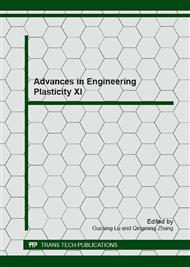p.219
p.223
p.227
p.231
p.235
p.239
p.243
p.247
p.250
Accurate Prediction Approach of 3D Trimming Line for Auto Panel Part
Abstract:
It is difficult to obtain 3D trimming line using traditional prediction methods for auto panel parts. An initial geometrical development method with element layer is proposed based on one step inverse analysis theory for this problem. The flange mesh can be unfold onto the die surface layer by layer according to nodal adjacent element relation, then the above development mesh is smoothed by mesh smoothing method with sliding constraint surface in order to delete overlap and distorted mesh, the 3D initial mesh can be obtained for one step inverse analysis method. The accurate 3D trimming line of auto panel part can be achieved by plasticity iteration of one step inverse analysis. A typical real part of 3D trimming line prediction is selected to prove this method, the comparison results between the simulated and experimental values show that this method has enough precision and can handle complex parts, satisfies the engineering practical demands.
Info:
Periodical:
Pages:
235-238
Citation:
Online since:
January 2013
Authors:
Price:
Сopyright:
© 2013 Trans Tech Publications Ltd. All Rights Reserved
Share:
Citation:


